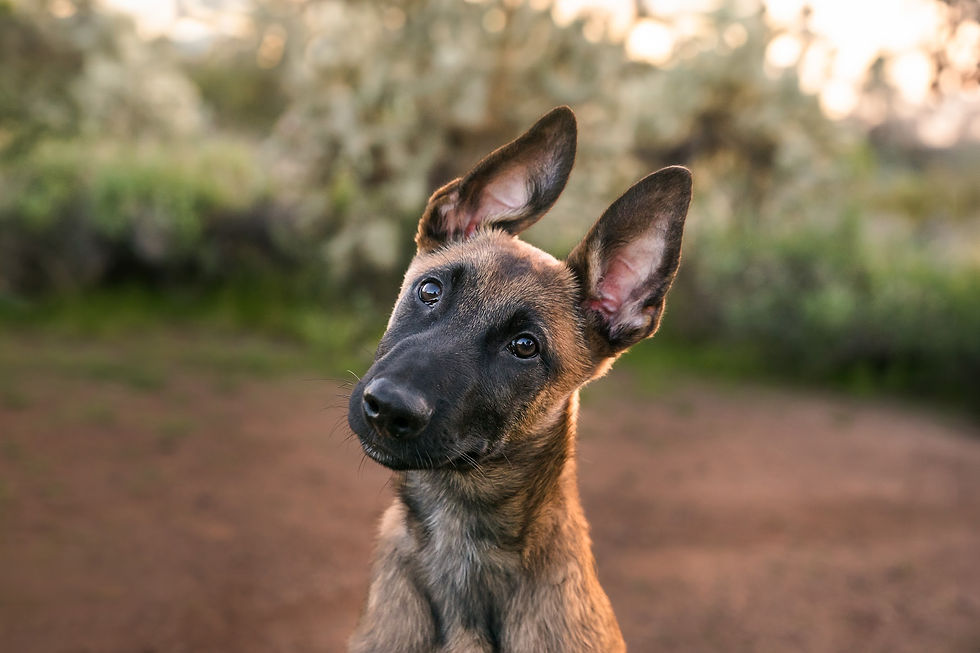How to Raise a Confident Puppy: Early Exposure, Independence & Calm Foundations
- Savage K9

- Aug 5
- 3 min read
Bringing a new puppy into your home is both exciting and overwhelming. Cuddles, playtime, and potty breaks are all important, but building long-term confidence should be the foundation of your pup’s early training.
Anxious and adult dogs often were puppies that didn’t learn how to be calm and confidently take on challenges during development windows. Confidence doesn’t mean dominant or fearless; it means a dog that is neutral and independent, especially in new or overstimulating environments. It takes intentionality when raising your puppy.
Below, there are three main pillars of confidence building that will be explored:
Neutral exposure
Threshold training
Early independence
If you’re worried about starting off right, book a free puppy-training consultation to raise your pup with purpose.
How do you Raise a Confident Puppy?

A confident puppy isn’t always the loudest or most playful one in the litter. It’s the dog that can explore without overstimulation, remain calm in new places, and recover quickly from unexpected situations.
Confidence in a puppy looks like:
Calm (not frantic) curiosity
Observe and not overreact
Explore without panicking
Comfortable being alone or without constant attention
Puppies that are clingy, reactive, or nervous won’t ‘grow out’ of that stage. They grow into it without clear boundaries and confidence practices early-on.
Neutral Exposure: Seeing the World Without Reacting

Socializing your dog doesn’t mean interacting with every person or dog you see. It’s about working to be neutral, observe new things, and not react out of overstimulation.
Successful neutral exposure looks like:
Watching people pass without lunging or barking
Hearing loud noises and recovering from the startle
Entering new environments without shutting down (i.e. being unresponsive)
Here’s how you can build neutral exposure:
Sit calmly and watch traffic from a distance
Crate your puppy in a new environment and allow them to settle
Walk near (but not at) people, dogs, and other stimuli like birds
Let your puppy observe more than interact. It’s crucial that you stay calm when building neutral exposure, and reward calm behavior and disengagement. Building a strong nervous system and lowering the chance of reactivity begins with you staying neutral.
IV. Threshold Training: Teaching Puppies to Pause

Thresholds (doorways, crate exits, or car doors) are both literal and metaphor places for your puppy to learn patience, control, and clarity. Pausing at thresholds helps your puppy learn that nothing happens - walks, car rides, or exiting the crate - without calm cooperation.
A simple threshold exercise:
Before going out the door, ask your puppy to sit and wait
Once they are calm, open the door
Release them with an “okay” or “break” command
Why does threshold training matter? It:
Teaches impulse control
Reduces overstimulation before activities
Builds a sense of predictability, which is crucial for young dogs
With threshold training, pausing before going becomes a mindset. Confidence grows in pups who have clear communication and consistent structure.
Encouraging Independence from Day One

One of the biggest mistakes puppy owners make is not giving their pup a moment alone. We get it - it’s easy to want to love a cute puppy 24/7. But constant attention creates dependency, and dependent dogs often have anxiety, over-attachment, and poor focus.
Easy ways to build independence in your puppy are:
Introducing short crate sessions in calm environments, like your bedroom
Giving your puppy a space to relax in another room with a chew toy or calm music
Using a “place stay” command to give them a safe spot to settle with busier surroundings like cooking a meal
With these exercises, your puppy will learn that you leaving the room isn’t a crisis. Instead, calm time is just as rewarding as active time. Confidence isn’t just about exploring the world, it's also about handling the quiet.
Book a Free Puppy Confidence Consultation

Whether you’re a first-time puppy owner or seasoned and trying to build a strong foundation, our free puppy-training consultations are here to help you. We offer complimentary consultations that will build a custom early training plan, exposure and calmness exercises, and guidance for building independence and structure.
Raising a confident puppy takes strategy. Focusing on neutral exposure, calm thresholds, and early independence will build an adult dog who can stay focused, balanced, and emotionally resilient.
Give the puppy the tools they deserve with a Savage K9 free consultation.
Comments